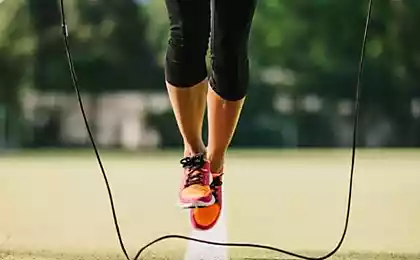305
3 main advantages of training with rope
The rope is one of the most versatile and affordable shells for a variety of trainings: both for weight loss and power. After all, jumping rope is not only an excellent cardio exercise, and they help not only lose weight, but also develop endurance, agility and speed.
3 main advantages of training with rope 1. Efficiency. For 1 hour jumping rope burns about 750 calories. At the same time, muscles are tightened, coordination develops, aerobic ability and endurance grow, posture and lymph and blood flow improve.
2. Availability. The rope costs a penny, does not take up space and fits even in a small bag, and therefore it is convenient to carry with you to work - and to engage in breaks between labors, and take on travel.
3. Convenience. You can train with the rope everywhere: at home, in the hall, on the street, in the office - if colleagues do not mind, etc.

What ropes are. 1. Simple kids. Inexpensive ropes with plastic handles and rubber cable, which are sold in ordinary stores and on street raska masonry. They may be short for adults.
2. Weighted. They're sold in sports stores. Equipped with heavy handles and a thick, tightly braided cable. They can unwind to very high speeds and create an additional load on the muscles of the legs and arms.
3. Speed. They make more revolutions per minute and are considered much more effective than regular ropes. It is easier to operate than heavy ones. Designed primarily for more intensive fat burning.
4. Electronic. Ropes equipped with meters - the number of jumps or calories. In the most "heaped" you can enter your parameters, and then use the rope as a kind of activity tracker.

After determining what type of rope you need, it is important to choose the right length of the projectile. They are usually produced in several sizes. Choose yours based on your own growth:
- up to 152 cm - you need a rope length of 210 cm;
- from 152 to 167 cm - 250 cm;
- from 167 to 183 cm - 280 cm;
- from 183 cm - 310 cm.
Since almost every rope has a length regulator in the handles, you can adjust it more accurately. To do this, you need to stand on the middle of the cable and, holding hands, straighten up. Then gently raise your hands, pulling the rope along the body. The handles should stop at the level of the armpits, but not lower. The optimal length allows you to jump, not pressing your legs much and making only small circular movements with your wrists.
Exercises with rope a lot, which means to diversify training with this projectile can be endless! It is important to follow a few simple rules:
- start training with warm-up;
Between exercises, rest twice as long as the exercise itself.
- at the end do a hitch and stretch.
You can start, for example, with such a complex, which should be performed 3 times a week:
1. Jumping on two legs at a calm pace.
2. Jumping with changing legs (from foot to foot).
3. Jumping on two legs with cross arms.
4. Jumping from left to right and back.
5. High-leg jumps.
6. Jumping on two legs at a calm pace.
Do not forget that jumping rope can not only be performed separately, but also combine them with interval training, running, walking or strength exercises.
Useful advice 1. Practice in your sneakers! Even at home, barefoot jumping should be avoided. When jumping, there is a rather serious load on the legs and joints. To avoid injuries, it is important to fix the ankle and create good cushioning.
2. Start with 5-10 minutes and increase the duration gradually!
3. Diversify the training, increasing the speed of jumps and changing the direction of rotation of the rope.
4. Watch for the correctness of the jumps: they must be made by pressing the elbows to the body and rotating only the hands. Your back should stay straight!
5. Landing should be only on the fingers, and not on the entire foot and especially not on the heels.
There are contraindications in rope and contraindications. And some groups of people should observe special caution, starting to master this sports projectile.
Classes with rope are contraindicated:
people who are overweight;
- suffering from hypertension and heart disease;
- those who have problems with the knees, spine and joints.
In addition, jumping rope is not allowed during pregnancy - at any time.
Read more articles about training with the rope
Possibly, in a few years these devices will become the same norm.
How to become a “candy” or an encyclopedia of misconceptions Famous fitness athlete, fitness expert and nutrition specialist Zina Rudenko wrote a book.
Kangoo Jumps: Jump and get thin! Kangoo Jumps is a new kind of fitness, which is rapidly gaining popularity in the field of fitness.
TOP-5 exercises for ideal legs and buttocks Many, especially women, in whom this area is most often problematic, persistently ...
Source: fitfixed.com
3 main advantages of training with rope 1. Efficiency. For 1 hour jumping rope burns about 750 calories. At the same time, muscles are tightened, coordination develops, aerobic ability and endurance grow, posture and lymph and blood flow improve.
2. Availability. The rope costs a penny, does not take up space and fits even in a small bag, and therefore it is convenient to carry with you to work - and to engage in breaks between labors, and take on travel.
3. Convenience. You can train with the rope everywhere: at home, in the hall, on the street, in the office - if colleagues do not mind, etc.

What ropes are. 1. Simple kids. Inexpensive ropes with plastic handles and rubber cable, which are sold in ordinary stores and on street raska masonry. They may be short for adults.
2. Weighted. They're sold in sports stores. Equipped with heavy handles and a thick, tightly braided cable. They can unwind to very high speeds and create an additional load on the muscles of the legs and arms.
3. Speed. They make more revolutions per minute and are considered much more effective than regular ropes. It is easier to operate than heavy ones. Designed primarily for more intensive fat burning.
4. Electronic. Ropes equipped with meters - the number of jumps or calories. In the most "heaped" you can enter your parameters, and then use the rope as a kind of activity tracker.

After determining what type of rope you need, it is important to choose the right length of the projectile. They are usually produced in several sizes. Choose yours based on your own growth:
- up to 152 cm - you need a rope length of 210 cm;
- from 152 to 167 cm - 250 cm;
- from 167 to 183 cm - 280 cm;
- from 183 cm - 310 cm.
Since almost every rope has a length regulator in the handles, you can adjust it more accurately. To do this, you need to stand on the middle of the cable and, holding hands, straighten up. Then gently raise your hands, pulling the rope along the body. The handles should stop at the level of the armpits, but not lower. The optimal length allows you to jump, not pressing your legs much and making only small circular movements with your wrists.
Exercises with rope a lot, which means to diversify training with this projectile can be endless! It is important to follow a few simple rules:
- start training with warm-up;
Between exercises, rest twice as long as the exercise itself.
- at the end do a hitch and stretch.
You can start, for example, with such a complex, which should be performed 3 times a week:
1. Jumping on two legs at a calm pace.
2. Jumping with changing legs (from foot to foot).
3. Jumping on two legs with cross arms.
4. Jumping from left to right and back.
5. High-leg jumps.
6. Jumping on two legs at a calm pace.
Do not forget that jumping rope can not only be performed separately, but also combine them with interval training, running, walking or strength exercises.
Useful advice 1. Practice in your sneakers! Even at home, barefoot jumping should be avoided. When jumping, there is a rather serious load on the legs and joints. To avoid injuries, it is important to fix the ankle and create good cushioning.
2. Start with 5-10 minutes and increase the duration gradually!
3. Diversify the training, increasing the speed of jumps and changing the direction of rotation of the rope.
4. Watch for the correctness of the jumps: they must be made by pressing the elbows to the body and rotating only the hands. Your back should stay straight!
5. Landing should be only on the fingers, and not on the entire foot and especially not on the heels.
There are contraindications in rope and contraindications. And some groups of people should observe special caution, starting to master this sports projectile.
Classes with rope are contraindicated:
people who are overweight;
- suffering from hypertension and heart disease;
- those who have problems with the knees, spine and joints.
In addition, jumping rope is not allowed during pregnancy - at any time.
Read more articles about training with the rope
Possibly, in a few years these devices will become the same norm.
How to become a “candy” or an encyclopedia of misconceptions Famous fitness athlete, fitness expert and nutrition specialist Zina Rudenko wrote a book.
Kangoo Jumps: Jump and get thin! Kangoo Jumps is a new kind of fitness, which is rapidly gaining popularity in the field of fitness.
TOP-5 exercises for ideal legs and buttocks Many, especially women, in whom this area is most often problematic, persistently ...
Source: fitfixed.com
Own state farmer from Virginia, Jeremiah Heaton
Built into the horn of cameras will help save rhinos from poachers























